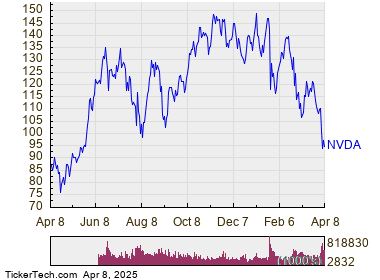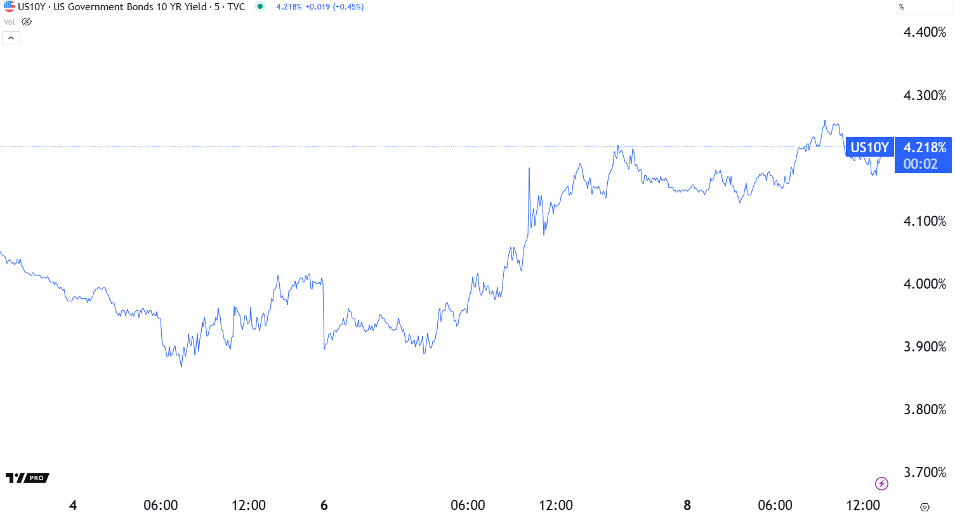Coffee Prices Plummet Amid Trade Fears and Weather Concerns
May arabica coffee (KCK25) is down -18.90 (-5.17%) today, while May ICE robusta coffee (RMK25) has fallen -301 (-5.89%). After a steady decline, coffee prices have dropped significantly for a second consecutive session. Arabica has reached a 2-1/4 month low, and robusta is at a 4-month low. Today’s risk-off sentiment in asset markets, driven by fears of a global trade war, has negatively impacted many commodity prices, including coffee. Growing concerns that rising tariffs will elevate coffee prices for consumers may further harm demand.
Commodity Bulletin: This FREE newsletter is designed for industry professionals and newcomers alike.
Losses for coffee accelerated after the Brazilian real (^USDBRL) fell to a 2-1/4 month low against the dollar, prompting Brazilian coffee producers to increase export selling. Coffee prices have struggled in recent weeks as recent rainfall in Brazil has eased earlier dryness concerns. Somar Meteorologia reported today that Minas Gerais, Brazil’s largest arabica growing region, received 39 mm of rainfall in the week ending April 5, which is 188% of the historical average.
Despite some easing of dryness, supply fears continue to support coffee prices. Cecafe reported a -12% year-on-year decrease in Brazil’s February green coffee exports, totaling 3 million bags. Furthermore, on January 28, Brazil’s official crop forecasting agency, Conab, lowered its 2025/26 coffee crop estimate by -4.4% year-on-year, projecting 51.81 million bags—its lowest level in three years. A subsequent reduction from September’s 54.8 million bag estimate showed a -1.1% decrease in the 2024 crop estimate, now at 54.2 million bags.
Additionally, tighter coffee inventories play a supportive role in pricing. ICE-monitored arabica coffee stocks fell to a 1-1/2 month low of 770,476 bags, while robusta inventories dropped to a 3-week low of 4,304 lots.
Support for coffee remains as Cooxupe, Brazil’s largest arabica coffee cooperative, indicated that high temperatures and below-average rainfall last month would negatively impact this year’s coffee yields. Brazil, being the largest arabica coffee producer globally, is under scrutiny for these developments.
On a negative note, Marex Solutions announced on March 7 an expected widening of the global coffee surplus in the 2025/26 season to 1.2 million bags, a significant increase from +200,000 bags in the 2024/25 season. Increased supplies present bearish conditions for robusta coffee. Projections indicate that Vietnam’s 2025/26 robusta production will reach 28.8 million bags, reflecting a +7.9% rise year-on-year, with Brazil’s output expected at 25 million bags, an increase of +13.6% year-on-year.
The lingering effects of last year’s El Nino may pose longer-term threats to coffee crops in South and Central America. Continuous below-average rainfall since April 2022 has damaged Brazilian coffee trees during flowering, consequently jeopardizing the prospects for the 2025/26 arabica coffee crop. Brazil has encountered its driest conditions since 1981, according to the disaster monitoring center, Cemaden. Meanwhile, Colombia, the second-largest arabica producer worldwide, is gradually rebounding from the drought conditions sparked by El Nino.
Robusta coffee pricing sees support from lowered production levels. Owing to drought, Vietnam’s coffee production in the 2023/24 crop year has dropped by -20% to 1.472 MMT, marking the lowest yield in four years. Additionally, Vietnam’s General Statistics Office reported that 2024 coffee exports have declined by -17.1% year-on-year to 1.35 MMT. The Vietnam Coffee and Cocoa Association also recently reduced its 2024/25 production estimate to 26.5 million bags, revising down from December’s forecast of 28 million bags. Finally, the Vietnam Customs Department indicated that Jan-March coffee exports fell -15.3% year-on-year to 495,780 MT, maintaining Vietnam’s status as the largest robusta coffee producer.
Increased global coffee exports are bearish for prices. Conab reported on February 4 that Brazil’s 2024 coffee exports increased by +28.8% year-on-year to a record-high of 50.5 million bags. However, the International Coffee Organization (ICO) found a -12.4% year-on-year decrease in global coffee exports for December, totaling 10.73 million bags, while Oct-Dec totals fell -0.8% year-on-year to 32.25 million bags.
The USDA’s biannual report on December 18 presented mixed outcomes for coffee prices. The USDA’s Foreign Agriculture Service (FAS) projected a +4.0% year-on-year increase in world coffee production for 2024/25, reaching 174.855 million bags. Arabica production is expected to increase by +1.5% to 97.845 million bags and robusta production by +7.5% to 77.01 million bags. The USDA’s FAS also forecasts a -6.6% drop in ending stocks, down to a 25-year low of 20.867 million bags from 22.347 million bags in the previous season. Separately, the USDA’s FAS projected Brazil’s 2024/25 coffee production at 66.4 MMT, lower than a prior forecast of 69.9 MMT, with inventories anticipated to hit 1.2 million bags, reflecting a 26% year-on-year decrease.
For the 2025/26 marketing year, Volcafe reported on December 17 that it had cut its Brazil arabica production estimate to 34.4 million bags, nearly 11 million bags less than a previous estimate due to the severity of ongoing drought conditions. The report anticipated a global arabica coffee deficit of -8.5 million bags for 2025/26, wider than the -5.5 million bag deficit expected for 2024/25, marking the fifth consecutive year of deficits.
On the date of publication, Rich Asplund did not have (either directly or indirectly) positions in any of the securities mentioned in this article. All information and data in this article is solely for informational purposes. For more information, please view the Barchart Disclosure Policy here.
The views and opinions expressed herein are solely those of the author and do not necessarily reflect those of Nasdaq, Inc.


